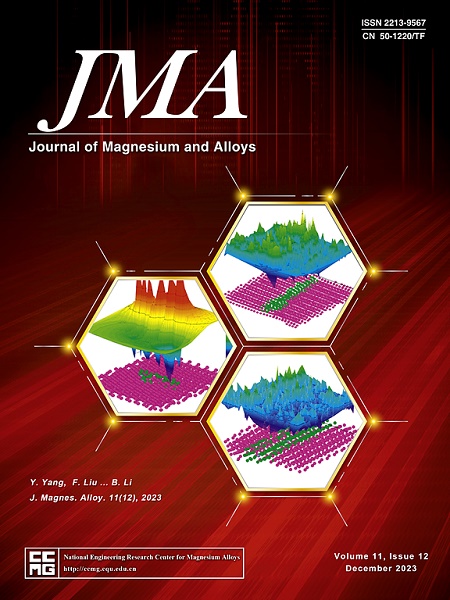异种焊接中纳米厚层界面固溶体的特殊冶金结合机制
IF 13.8
1区 材料科学
Q1 METALLURGY & METALLURGICAL ENGINEERING
引用次数: 0
摘要
在异种焊接中,界面冶金结合通常涉及脆性金属间化合物(IMCs)的形成。没有界面IMCs的有效结合仅在少数具有高相互溶解度的组合中被报道,例如Ag/Au,或者在涉及Al/钢焊接的有限特定情况下,在那里形成了界面非晶相。采用高分辨透射电镜研究了非混相AZ31镁合金与DC01钢搅拌摩擦搭接焊接的一种新的冶金结合机制。与IMCs不同,AZ31和DC01是通过Al原子从AZ31扩散而形成的纳米厚的Fe(Al)固溶体界面层结合的。AZ31/DC01接头的搭接抗剪强度达到101 MPa,是AZ31母材抗剪强度的78%,比纯Mg/DC01接头抗剪强度提高89%。断裂主要发生在AZ31搅拌区,而不是沿界面右侧断裂。本文章由计算机程序翻译,如有差异,请以英文原文为准。

Exceptional metallurgical bonding mechanism via Nano-thick layer of interfacial solid solution in dissimilar welding
In dissimilar welding, interfacial metallurgical bonding typically involves the formation of brittle intermetallic compounds (IMCs). Effective bonding without interfacial IMCs was reported only in a few combinations with high mutual solubility, such as Ag/Au, or in limited specific cases involving Al/steel welding, where interfacial amorphous phases formed. This study reveals a new metallurgical bonding mechanism in friction stir lap welding between immiscible AZ31 Mg alloy and DC01 steel, using high-resolution transmission electron microscopy. Rather than IMCs, AZ31 and DC01 were bonded via a nanometer-thick interfacial layer of Fe(Al) solid solution formed by Al atoms diffusing across the interface from AZ31. This mechanism was found highly effective, as evidenced by the lap shear strength of AZ31/DC01 joint, reaching 101 MPa, which is 78 % of the shear strength of AZ31 base material and 89 % higher than that of pure Mg/DC01 joint. Fracture predominantly occurred in AZ31 stir zone rather than right along interface.
求助全文
通过发布文献求助,成功后即可免费获取论文全文。
去求助
来源期刊

Journal of Magnesium and Alloys
Engineering-Mechanics of Materials
CiteScore
20.20
自引率
14.80%
发文量
52
审稿时长
59 days
期刊介绍:
The Journal of Magnesium and Alloys serves as a global platform for both theoretical and experimental studies in magnesium science and engineering. It welcomes submissions investigating various scientific and engineering factors impacting the metallurgy, processing, microstructure, properties, and applications of magnesium and alloys. The journal covers all aspects of magnesium and alloy research, including raw materials, alloy casting, extrusion and deformation, corrosion and surface treatment, joining and machining, simulation and modeling, microstructure evolution and mechanical properties, new alloy development, magnesium-based composites, bio-materials and energy materials, applications, and recycling.
 求助内容:
求助内容: 应助结果提醒方式:
应助结果提醒方式:


